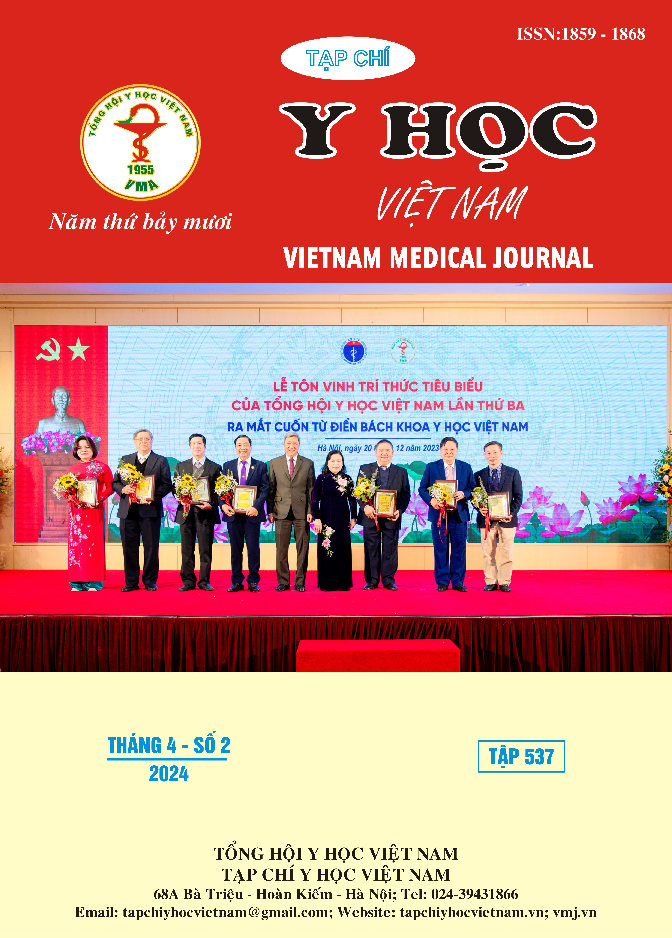NGHIÊN CỨU HOẠT TÍNH CHỐNG OXY HOÁ CỦA CÁC CHẤT CHUYỂN HOÁ PHÂN LẬP TỪ PHẦN RỄ CỦA LOÀI DONG RIỀNG CANNA INDICA L. ĐỊNH HƯỚNG PHÒNG VÀ ĐIỀU TRỊ BỆNH TIM MẠCH
Nội dung chính của bài viết
Tóm tắt
Canna indica L. là loài dong riềng có tiềm năng trong phòng và điều trị bệnh tim mạch. Nghiên cứu này nhằm mục đích đánh giá hoạt tính chống oxy hoá của các chất chuyển hoá phân lập lần đầu tiên từ cây dong riềng C. indica. Phương pháp đánh giá khả năng bắt gốc tự do DPPH và ABTS được sử dụng để đánh giá hoạt tính chống oxy hoá của 8 chất gồm canindicoside A (1), canindicoide B (2), axit S-(-)-rosmarinic metyl ester (3), axit isorinic (4), stiryst-4-ene-3,6-dione (5), 6β-hydroxystigmast-4-en-3-one (6), axit ent-kaur-15-ene-19-al-17-oic (7) và axit 16α-hydro-19-ol-ent-kauran-17-oic (8). Kết quả cho thấy chất 3 thể hiện hoạt tính chống oxy hoá mạnh nhất, rồi đến chất 4, 1, 7 và 2. Chất 6 thể hiện hoạt tính chống oxy hoá yếu nhất, còn chất 5 và 8 không thể hiện hoạt tính chống oxy hoá. Đây là kết quả có ý nghĩa khoa học rằng phần rễ của C. indica là nguồn thảo dược tiềm năng để nghiên cứu các hoạt chất có hoạt tính sinh học, đồng thời có thể nghiên cứu phát triển các sản phẩm thực phẩm chức năng ứng dụng trong phòng và điều trị bệnh tim mạch và các bệnh liên quan đến stress oxy hoá.
Chi tiết bài viết
Từ khóa
dong riềng, Canna indica, chất chống oxy hóa, thân rễ.
Tài liệu tham khảo
2. Oana, Y.,Balakyz ,A. R., Ahmad, F. M., Babagana C.,Daniela S. R. (2023). Oxidative stress, free radicals and antioxidants: potential crosstalk in the pathophysiology of human diseases, Frontiers in Chemistry. 11(2023):1158198.
3. Al-Snafi, A.S., 2015. Bioactive components and pharmacological effects of Canna indica - an overview. Int. J. Pharmacol. Toxicol. 5(2015): 71–75.
4. Kumbhar, S.T., Patil, S.P., Une, H.D. (2018). Phytochemical analysis of Canna indica L. roots and rhizomes extract. Biochem. Biophys. Rep. 16(2018): 50–55.
5. Nguyen, T. V. A, Nguyen, T. M. H., Le, H. L., Bui, D. H. (2023). Potential antithrombotic effect of two new phenylpropanoid sucrose esters and other secondary metabolites of Canna indica L. rhizome. Nat Prod Res (2023): 1-9.
6. Nguyen, T. V. A, Nguyen, T. M. H., Le, H. L., Bui, D. H. (2023). Antithrombotic Activity of the Steroids and ent‑Kaurane Diterpenoids from Canna indica Rhizomes. Rev Bras Farmacgn (2023).
7. Le, H. L., Nguyen, T. M. H., Vu, T. T., Nguyen, T. T. O., Duong, T. L. H., Le, N. T., Nguyen, V. H., Nguyen, T. V. A. (2022). Potent antiplatelet aggregation, anticoagulant and antioxidant activity of aerial Canna x generalis L.H Bailey & E.Z Bailey and its phytoconstituents. S. Afr. J. Bot. 147(2023): 882-893.
8. Indrayan, A. K., Bhojak, N. K., Kumar, N., Shatru, A. and Gaura A. (2011). Chemical composition and antimicrobial activity of the essential oil from the rhizome of Canna indica Linn. Indian Journal of Chemistry. 50B(2011): 1136-1139.
9. Ayusman, S., Duraivadivel, P., Gowtham, H. G., Sharma, S Hariprasad, P. Bioactive constituents, vitamin analysis, antioxidant capacity and α-glucosidase inhibition of Canna indica L. rhizome extracts. Food Biosci. 35(2020): 100544


